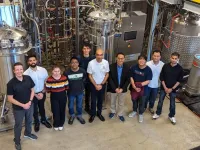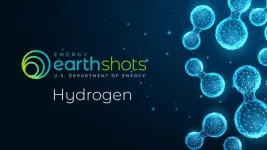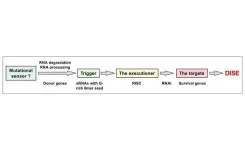(Press-News.org) Agriculture in Syria started with a bang 12,800 years ago as a fragmented comet slammed into the Earth’s atmosphere. The explosion and subsequent environmental changes forced hunter-gatherers in the prehistoric settlement of Abu Hureyra to adopt agricultural practices to boost their chances for survival.
That’s the assertion made by an international group of scientists in one of four related research papers, all appearing in the journal Science Open: Airbursts and Cratering Impacts. The papers are the latest results in the investigation of the Younger Dryas Impact Hypothesis, the idea that an anomalous cooling of the Earth almost 13 millennia ago was the result of a cosmic impact.
“In this general region, there was a change from more humid conditions that were forested and with diverse sources of food for hunter-gatherers, to drier, cooler conditions when they could no longer subsist only as hunter-gatherers,” said Earth scientist James Kennett, a professor emeritus of UC Santa Barbara . The settlement at Abu Hureyra is famous among archaeologists for its evidence of the earliest known transition from foraging to farming. “The villagers started to cultivate barley, wheat and legumes,” he noted. “This is what the evidence clearly shows.”
These days, Abu Hureyra and its rich archaeological record lie under Lake Assad, a reservoir created by construction of the Taqba Dam on the Euphrates River in the 1970s. But before this flood, archaeologists managed to extract loads of material to study. “The village occupants,” the researchers state in the paper, “left an abundant and continuous record of seeds, legumes and other foods.” By studying these layers of remains, the scientists were able to discern the types of plants that were being collected in the warmer, humid days before the climate changed and in the cooler, drier days after the onset of what we know now as the Younger Dryas cool period.
Before the impact, the researchers found, the inhabitants’ prehistoric diet involved wild legumes and wild-type grains, and “small but significant amounts of wild fruits and berries.” In the layers corresponding to the time after cooling, fruits and berries disappeared and their diet shifted toward more domestic-type grains and lentils, as the people experimented with early cultivation methods. By about 1,000 years later, all of the Neolithic “founder crops” — emmer wheat, einkorn wheat, hulled barley, rye, peas, lentils, bitter vetch, chickpeas and flax — were being cultivated in what is now called the Fertile Crescent. Drought-resistant plants, both edible and inedible, become more prominent in the record as well, reflecting a drier climate that followed the sudden impact winter at the onset of the Younger Dryas.
The evidence also indicates a significant drop in the area’s population, and changes in the settlement’s architecture to reflect a more agrarian lifestyle, including the initial penning of livestock and other markers of animal domestication.
To be clear, Kennett said, agriculture eventually arose in several places on Earth in the Neolithic Era, but it arose first in the Levant (present-day Syria, Jordan, Lebanon, Palestine, Israel and parts of Turkey) initiated by the severe climate conditions that followed the impact.
And what an impact it must have been.
In the 12,800-year-old layers corresponding to the shift between hunting and gathering and agriculture, the record at Abu Hureyra shows evidence of massive burning. The evidence includes a carbon-rich “black mat” layer with high concentrations of platinum, nanodiamonds and tiny metallic spherules that could only have been formed under extremely high temperatures — higher than any that could have been produced by man’s technology at the time. The airburst flattened trees and straw huts, splashing meltglass onto cereals and grains, as well as on the early buildings, tools and animal bones found in the mound — and most likely on people, too.
This event is not the only such evidence of a cosmic airburst on a human settlement. The authors previously reported a smaller but similar event which destroyed the biblical city at Tall el-Hammam in the Jordan Valley about 1600 BCE.
The black mat layer, nanodiamonds and melted minerals have also been found at about 50 other sites across North and South America and Europe, the collection of which has been called the Younger Dryas strewnfield. According to the researchers, it’s evidence of a widespread simultaneous destructive event, consistent with a fragmented comet that slammed into the Earth’s atmosphere. The explosions, fires and subsequent impact winter, they say, caused the extinction of most large animals, including the mammoths, saber-toothed cats, American horses, and American camels, as well as the collapse of the North American Clovis culture.
Because the impact appears to have produced an aerial explosion there is no evidence of craters in the ground. “But a crater is not required,” Kennett said. “Many accepted impacts have no visible crater.” The scientists continue to compile evidence of relatively lower-pressure cosmic explosions — the kind that occur when the shockwave originates in the air and travels downward to the Earth’s surface.
“Shocked quartz is well known and is probably the most robust proxy for a cosmic impact,” he continued. Only forces on par with cosmic-level explosions could have produced the microscopic deformations within quartz sand grains at the time of the impacts, and these deformations have been found in abundance in the minerals gathered from impact craters.
This “crème de la crème” of cosmic impact evidence has also been identified at Abu Hureyra and at other Younger Dryas Boundary (YDB) sites, despite an absence of craters. However, it has been argued that the kind of shock-fractured quartz found in the YDB sites is not equivalent to that found in the large crater-forming sites, so the researchers worked to link these deformations to lower-pressure cosmic events.
To do so, they turned to manmade explosions of the magnitude of cosmic airbursts: nuclear tests conducted at the Alamogordo Bombing Range in New Mexico in 1945 and in Kazakhstan, in 1949 and 1953. Similar to cosmic airbursts, the nuclear explosions occurred above ground, sending shockwaves toward Earth.
“In the papers, we characterize what the morphologies are of these shock fractures in these lower-pressure events,” Kennett said. “And we did this because we wanted to compare it with what we have in the shock-fractured quartz in the Younger Dryas Boundary, to see if there was any comparison or similarities between what we see at the Trinity atomic test site and other atomic bomb explosions.” Between the shocked quartz at the nuclear test sites and the quartz found at Abu Hureyra, the scientists found close associations in their characteristics, namely glass-filled shock fractures, indicative of temperatures greater than 2,000 degrees Celsius, above the melting point of quartz.
“For the first time, we propose that shock metamorphism in quartz grains exposed to an atomic detonation is essentially the same as during a low-altitude, lower-pressure cosmic airburst,” Kennett said. However, the so-called “lower pressure” is still very high — probably greater than 3 GPa or about 400,000 pounds per square inch, equivalent to about five 737 airplanes stacked on a small coin. The novel protocol the researchers developed for identifying shock fractures in quartz grains will be useful in identifying previously unknown airbursts that are estimated to recur every few centuries to millennia.
Taken together, the evidence presented by these papers, according to the scientists, “implies a novel causative link among extraterrestrial impacts, hemispheric environmental and climatic change, and transformative shifts in human societies and culture, including agricultural development.”
END
A prehistoric cosmic airburst preceded the advent of agriculture in the Levant
2023-10-04
ELSE PRESS RELEASES FROM THIS DATE:
Is universal screening for type 1 diabetes around the corner?
2023-10-04
The the latest data on universal screening for type 1 diabetes (T1D) is reveiwed in a session at this year’s Annual Meeting of the European Association for the Study of Diabetes (EASD) in Hamburg, Germany (2-6 October). The talk will be given by Dr Emily K. Sims, Associate Professor of Pediatrics, Center for Diabetes and Metabolic Diseases, Indiana University School of Medicine, Indianapolis, IN, USA.
Research by various groups has established that individuals with multiple islet autoantibodies (biomarkers showing that the body is attacking and killing its own insulin producing beta cells in ...
Metabolic signature can help predict which smokers will develop type 2 diabetes
2023-10-04
New research being presented at this year’s Annual Meeting of The European Association for the Study of Diabetes (EASD), Hamburg (2-6 Oct) finds that cigarette smoking increases the risk of developing type 2 diabetes in part by affecting a variety of metabolites—small chemicals produced in the processes of metabolism—that circulate in the bloodstream.
The influence of these metabolic changes on diabetes risk appears to be amplified in individuals with genetic susceptibility to type 2 diabetes or insulin resistance.
The analysis of over 93,000 UK Biobank participants also identified a metabolic ...
Metabolically healthy obesity: fact or fiction?
2023-10-04
A session at this year’s Annual Meeting of the European Association for the Study of Diabetes will explore the latest data on the concept of metabolically healthy obesity (MHO) – more commonly known by the public as ‘fat but fit’. Professor Matthias Blüher, University of Leipzig, Leipzig and Helmholtz Center Munich, Germany will explain how we define MHO and ask if it can really be described as healthy.
“Some 15-20% of people living with obesity have none ...
Emergency department screening could detect thousands of undiagnosed prediabetes and diabetes cases, UK study suggests
2023-10-04
The introduction of screening for type 2 diabetes in Accident and Emergency (A&E) departments could uncover thousands of previously undiagnosed cases every year, suggests new research being presented at this year’s Annual Meeting of The European Association for the Study of Diabetes (EASD), Hamburg (2-6 Oct).
“Early diagnosis is the best way to avoid the devastating complications of type 2 diabetes, and offers the best chance of living a long and healthy life”, says Professor Edward Jude, Tameside and Glossop Integrated Care NHS Foundation Trust, UK. “Symptoms of type 2 diabetes may be absent and can be tricky ...
New stem cell-derived islet therapy improves blood sugar control in all treated patients, with three achieving insulin independence
2023-10-04
Six adults with type 1 diabetes (T1D) treated with stem cell-derived islet cells (VX-880) have shown improved blood sugar control with three participants achieving insulin independence, according to new research being presented at this year’s Annual Meeting of The European Association for the Study of Diabetes (EASD), Hamburg (2-6 Oct).
All patients treated with VX-880 have demonstrated improved glycaemic control, as evidenced by elimination of severe hypoglycaemia (low blood sugar), improvements in HbA1c (a measure of long-term sugar levels) and the amount of time their ...
New pipeline makes valuable organic acid from plants — saving money and emissions
2023-10-03
In a breakthrough for environmentally friendly chemical production, researchers at the Center for Advanced Bioenergy and Bioproducts Innovation (CABBI) have developed an economical way to make succinic acid, an important industrial chemical, from sugarcane.
The team of University of Illinois and Princeton University researchers created a cost-effective, end-to-end pipeline for this valuable organic acid by engineering a tough, acid-tolerant yeast as the fermenting agent, avoiding costly steps in downstream processing. Succinic acid is a widely ...
PARMESAN: An AI-based predictive tool to find new treatments for genetic disorders
2023-10-03
To discover new treatments for genetic disorders, scientists need a thorough knowledge of prior literature to determine the best gene/protein targets and the most promising drugs to test. However, biomedical literature is growing at an explosive rate and often contains conflicting information, making it increasingly time-consuming for researchers to conduct a complete and thorough review.
To address this challenge, Cole Deisseroth, a graduate student enrolled in the M.D./Ph.D. program and mentored by Drs. Huda Zoghbi and Zhandong Liu at the Jan and Duncan ...
PPPL awarded $5 million to lead an Energy Earthshot Research Center focused on clean hydrogen
2023-10-03
Lessening the effects of climate change will require a variety of innovations and a lot of ingenuity. Now, a new center led by the U.S. Department of Energy’s (DOE) Princeton Plasma Physics Laboratory (PPPL) will help these efforts by advancing the understanding of plasma-based clean hydrogen production.
PPPL was selected to lead a DOE Energy Earthshot Research Center (EERC) as part of the Hydrogen Shot™, which aims to reduce the cost of hydrogen by 80%. With funding from the DOE’s Office of Science, the EERCs support fundamental ...
Illinois-led project to sequence 400 soybean genomes, improve future crops
2023-10-03
As a source of protein and biodiesel for cleaner renewable energy, soybean is an important crop worldwide. But is it performing to its full potential? An ambitious effort led by the University of Illinois Urbana-Champaign and the U.S. Department of Energy Joint Genome Institute (JGI) will sequence 400 soybean genomes to develop a “pangenome” — an attempt to characterize all the useful diversity in the genome to create an even more robust and resilient crop.
The soybean pangenome project will sequence and analyze at least 50 soybean genomes from cultivated lines and wild relatives at reference quality, the gold standard of modern sequencing. A further ...
An ancient anti-cancer mechanism: DISE
2023-10-03
“DISE is effective against all cancers we tested.”
A new editorial paper was published in Oncotarget's Volume 14 on September 25, 2023, entitled, “DISE, an ancient anti-cancer mechanism that senses mutational load in cancerous cells?”
In their new editorial, researchers Monal Patel and Marcus E. Peter from Northwestern University discuss a recent breakthrough in cancer therapy. Despite the multiple advances in therapy, cancer remains one of the most common causes of death globally. ...



